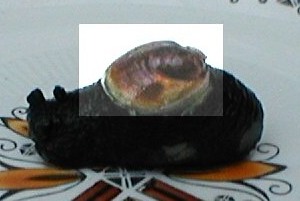Re: Commensal bivalve - Sea Hare
June 17, 2002
From: Dr. Stephen R. Hoskins

Dear Bill,
I have attached the digital photo showing the bivalve attached to the sea hare, both of which I preserved. I have tried to "clean" up the bivalve part and hopefully its colour will be more appreciable against the dark sea hare.
Thanks,
Stephen.
SRH@4TheNet.co.uk
Hoskins, S.R., 2002 (Jun 17) Re: Commensal bivalve - Sea Hare. [Message in] Sea Slug Forum. Australian Museum, Sydney. Available from http://www.seaslugforum.net/find/7271Dear Stephen,
Thanks for the photo - it certainly puts a new light on your observation. The shell is in fact the shell of the Sea Hare. Have a look at the Sea Hare Shell page and my comment on the Sea Hare siphon for an idea on Sea Hare anatomy. In most species of Sea Hare the shell is well enclosed within the mantle tissue, but in a few species like A. punctata and A. parvula there is a wide opening [mantle foramen] in the mantle tissue exposing quite a bit of the shell to the outside world. When these animals get old and worn out, this opening gets bigger and bigger as the mantle tissue loses 'muscle tone' and the shell becomes even more exposed.
It would have been nice if you had found a new association for a galeommatid bivalve, as we know very little about their natural history, but at least its nice for you to know why these apparent bivalves were hanging on so tightly!
Best wishes,
Bill Rudman
Related messages
-
Re: Aplysia punctata mating, spawning and variations
From: Joao Pedro Tojal Loia Soares Silva, October 3, 2007 -
Aplysia punctata from the Western Isles, Scotland
From: Lindsay Bradley, October 3, 2007 -
Aplysia punctata mating, spawning and variations
From: Joao Pedro Silva, August 20, 2007 -
Aplysia punctata mating
From: Jim Anderson, August 20, 2007 -
Re: Appetitive behaviour in Aplysia
From: Mark Henry, August 22, 2006 -
Appetitive behaviour in Aplysia
From: Mark Henry, August 21, 2006 -
Markings on Aplysia punctata
From: Mark Henry, August 17, 2006 -
A summer spawn of Aplysia punctata
From: Mark.Henry, August 15, 2006 -
Sea Hare from Lochiver, Northwest Scotland
From: Colin Robertson, March 28, 2006 -
Spanish Sea Hares
From: Sascha Schulz, February 20, 2006 -
Sea Hare from Spain
From: Raul Castro, December 17, 2005 -
Aplysia punctata from Scotland
From: Cherry Welsh, August 19, 2005 -
Juvenile Aplysia from Norway
From: Kåre Telnes, July 30, 2005 -
Aplysia punctata from Croatia
From: Andrej Jaklin, March 4, 2005 -
Aplysia from Croatia
From: Andrej Jaklin, March 4, 2005 -
Age determination of Aplysia punctata
From: Marta K. Soffker, February 18, 2005 -
Aplysia punctata mating
From: Jim Anderson, November 27, 2003 -
Aplysia punctata from French Mediterranean
From: Marina Poddubetskaia, July 19, 2003 -
Aplysia punctata (adult) from French Brittany
From: Marina Poddubetskaia, April 29, 2003 -
Aplysia punctata (juvenile) from French Brittany
From: Marina Poddubetskaia, April 29, 2003 -
Aplysia punctata in aquarium
From: Michael, November 10, 2002 -
Re: commensal bivalve & Aplysia
From: Dr.Stephen R Hoskins, June 18, 2002 -
Re: galeommatoidean commensal on Aplysia?
From: Serge Gofas , June 13, 2002 -
Aplysia punctata and commensal? bivalve.
From: Stephen Hoskins, June 8, 2002 -
Aplysia punctata in Germany
From: Peter Gleisenstein , May 31, 2002 -
Aplysia punctata & 'passengers'
From: Dr. Stephen Hoskins, May 16, 2002 -
Aplysia punctata from Portugal
From: João Tojal Silva, April 23, 2002 -
Aplysia punctata defensive mechanism
From: Marilyn Jackson, December 13, 2000 -
What does Aplysia punctata eat?
From: Trevor Shand, August 7, 2000 -
Observations on Aplysia punctata
From: Andy Horton, October 2, 1999
